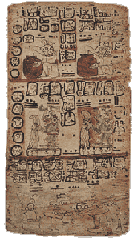The Maya
By maya On October 30thOne of the most amazing cultures of the New World inhabited a region encompassing today’s Guatemala, Belize, Honduras and El Salvador, and parts of southern Mexico (the states of Yucatan, Campeche, Quintana Roo, Tabasco and Chiapas). Today this area is occupied by the descendants of the ancient Maya, the vast majority of whom have to some extent preserved their cultural heritage and still speak the Mayan language.
By 5000 BC, the Maya had settled along the Caribbean and Pacific coasts, in fishing communities. By 2000 BC the Maya had also moved inland and adopted agriculture for their subsistence. Maize and beans formed the Maya diet then as today, although many other foodstuffs–manioc, squash, tomatoes, peppers, fruit, and game-were supplements.
To study the Maya their development has been divided into periods, the earlier Maya culture is called Formative or Pre Classic (2000 BC-AD 300), the Classic period goes from AD 300 to AD 900, and subsequent civilization is known as Post Classic (AD 900-conquest).
Now we know that the Maya began to develop intensive agriculture and sophisticated water management during the Middle Pre Classic (900-300 BC), surely to help support the population explosion of the Late Pre Classic (300 BC-AD 300). During this same period, writing was invented in Mesoamerica, and the Maya began to use it during the Late Pre Classic.
 The Maya were the first people of the New World to keep historical records, and even if writing in the New World did not originate among the Maya, they developed and used it extensively. The Maya wrote a mixed script, with ideographic and phonetic elements.
The Maya were the first people of the New World to keep historical records, and even if writing in the New World did not originate among the Maya, they developed and used it extensively. The Maya wrote a mixed script, with ideographic and phonetic elements.
Most of their writing survived on stelae, stone monuments very common in the Maya cities, they recount mostly civil events and record their calendric and astronomical knowledge.
Maya pottery gives testimony of their religion and elaborate mythology. Four Post Classic Maya screenfold manuscripts, called codices have survived, They reveal Maya calendric and astronomical calculations, as well as rituals, offerings, and auguries for the year.
The Maya used several calendars simultaneously. One of them called the “long count”, is a continuous record of days from a zero date that correlates to Aug. 13, 3114 BC, and is more precise than the Julian calendar revised in Europe in 1582. The Maya were great astronomers and kept track of the solar and lunar years, eclipses and the cycles of visible planets. To carry out their calendric and astronomical calculations they developed a sophisticated mathematical system where units are written with dots and bars are used to represent five units. They discovered and used the zero as well as a vigesimal positioning system, similar to the decimal positioning system we use today.
During the Classic period monumental architecture and stelae with historical records were erected, on these monuments the Maya rulers reigned as divine kings. The Maya thrived during the Late Classic (AD 550-900), and art, architecture, writing, commerce and intensive agricultural practices flourished all through the Maya lands. More than 2 million people may have lived in the area, and it is estimated that Tikal, the largest center, had a population of 75,000-100,000.
However, the Classic Maya cities did not survive into the 10th century. It seems that the system of rule that had served them well for centuries failed. Probably faced with famine, foreign invasion, chronic warfare, adverse climatic conditions and perhaps disease, the Classic period ended in what is called the Classic Maya collapse. The Maya continued to live in both highlands and lowlands but the period of their greatest splendor was over. In the northern Yucatan peninsula, civilization continued at Uxmal and the surrounding area. The Post Classic saw the splendor of Chichen Itza. Chichen Itza was probably abandoned by the 12th century. Trading towns survived along the Caribbean coast. Tulum, a spectacular walled city and a major trading town, located above the coastline of what is now the state of Quintana Roo on Mexico’s Caribbean seashore is a great example of these. This city when seen from a Spanish ship was compared to Seville.
The Maya of Yucatan finally broke up into small states and the Spanish took advantage of this division to take control in 1542. In that year, after having been fought back during 15 years, they were able to establish their own capital at Mérida, (in today’s State of Yucatan, Mexico) on the site of a Maya city called Tiho. The last of the Maya kingdoms, Tayasal, in Lake Peten Itza (Guatemala), was conquered by the Spanish in 1697, 155 years after the conquest of Merida.
[Source: Maya Calendar]

